3D printing of medical devices can be traced back to the invention of 3D printing in the 1980s. It is still evolving toward making revolutionary changes in the manufacturing industry. Even though it’s fairly a new, 3D printing manages to reach an inflection point in the healthcare industry. It can overcome limitation that are frequent in other techniques such as injection molding or CNC milling.
3D printing was initially very expensive.That’s why it was accessible only to the largest medical device manufacturers in the industry. Its continuous revolution has led to 3D printers becoming more and more affordable and accessible. This has enabled various types of medical device manufacturers to develop personalized medical devices.
These techniques have enabled the development of novice medical devices that are safe, patient-specific, biocompatible, and sterilizable. We can expect healthcare to be more efficient in the future, as patients can now receive a personalized approach.
Additive manufacturing has helped researchers and industry innovators to fast-track the development of medical devices. It has also enabled them to set an unprecedented speed from concept to mass production of emergency medical supplies. This has been observed in particular in 2020s during the Covid-19 outbreak.
Recently, in-house 3D printing techniques have also enabled medical device manufacturers to significantly reduce time and costs. In this article, we show various 3D printing applications for medical devices, followed by a comparison of common 3D printing processes that are applied in the medical device industry. Finally, an overview of the regulatory process involved will be provided.
Additive Manufacturing in the Medical Device Sector
What are Medical Devices?
These techniques have a wide range of use cases in the medical device industry due to their ability to break limitations, combine speed with affordability, and offer customizations.
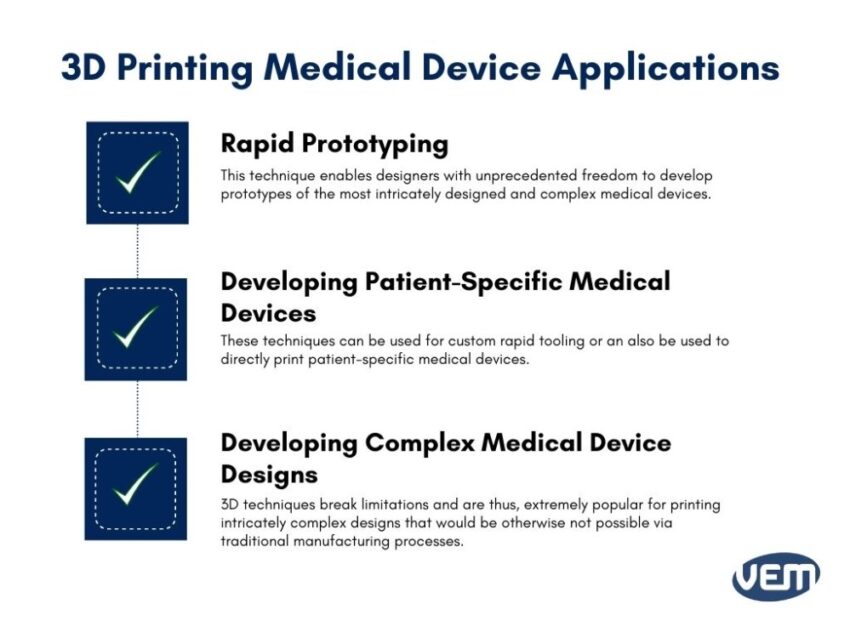
Let’s take a look at some medical device applications that incorporate 3D printing techniques:
Rapid Prototyping
Rapid prototyping is a technique that can create a model of a plastic part using 3-D CAD (computer-aided design) data. 3D printing techniques enable designers with unprecedented freedom and provide manufacturers with the flexibility to develop prototypes of even the most intricately designed and complex medical devices. Through 3D printing, new iterations can be implemented and completed within a fraction of the time. This speed in the process helps to determine if further changes are required.
3D printing eliminates initial tooling and can produce parts with similar mechanical properties. It also enables the development of medical device prototypes using various types of materials. 3D-printed medical device prototypes are also used in exhibitions for presentations as well as for pitching investors or engaging with future customers.
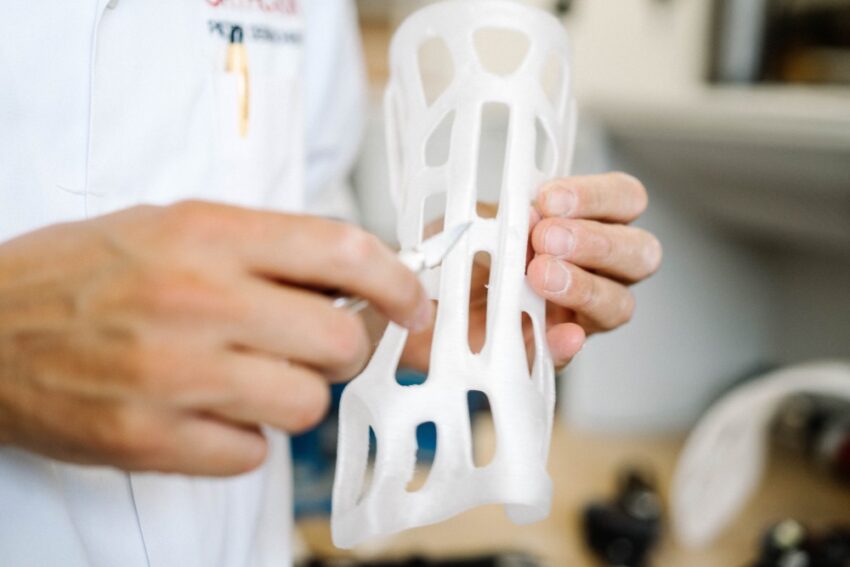
Developing Patient-Specific Medical Devices
Traditional manufacturing processes have expensive tooling requirements and are thus not efficient for manufacturing patient-specific medical devices that are often personalized to suit the patient’s requirements.
3D techniques can be adopted in one of the following ways to develop patient-specific medical devices.
- 3D printing techniques can be used for custom rapid tooling. It can be used to create 3D-printed molds, casts, and patterns for injection molding, thermoforming, and other manufacturing methods.
- These techniques can also be used to directly print patient-specific medical devices. Since tooling isn’t a necessity, it is possible to manufacture specific custom parts cost-efficiently.
Dentistry is one of the main industries that has adopted 3D-printing techniques to manufacture custom medical devices which is then followed by surgical guides, splints, and restorations. Other end-use of medical 3D printing applications include custom-fit ear devices such as hearing aids and noise protection equipment as well as strong and durable custom prosthetics, orthotics, and more.
Developing Complex Medical Device Designs
One of the reasons that 3D printing technology has gained immense popularity in the medical industry is that it enabled designers and manufacturers to break the limitations of traditional manufacturing methods. 3D techniques are extremely popular for printing intricately complex designs that would be otherwise not possible via traditional manufacturing processes.
3D Printing Techniques for Medical Devices
There are various types of 3D printing techniques and all of them have several pros and cons. Not every printing technique is suited for every project thus, it’s imperative to understand the right printing technology for your project.
Some of the most popular 3D printing technologies are stereolithography (SLA), selective laser sintering (SLS), fused deposition modeling (FDM), direct metal laser sintering (DMLS), and selective laser melting (SLM). Let’s understand these techniques in detail and how they are used to manufacture medical devices:

Stereolithography (SLA)
Stereolithography, abbreviated for SLA, is one of the most popular 3D-printing techniques for medical devices due to its accuracy, high resolution, and precision. It is an additive manufacturing process that utilizes the photopolymerization technique. SLA 3D printers create objects by selectively curing a polymer resin, layer by layer, using ultraviolet light. SLA materials are photosensitive, liquid thermoset polymers.
The plastic parts that are manufactured through the SLA technique have the highest resolution and accuracy. They also have the clearest details and the smoothest surface finish of all plastic 3D printing technologies thus, they are great for prototypes. Thus, this technique is highly preferred by manufacturers for developing intricately designed and detailed medical devices that require tight tolerances. SLA techniques also offer versatility and a wide selection of biocompatible materials to choose from for medical and dental applications. SLA techniques are more affordable than other 3D printing techniques but not as affordable as FDM.
One of the major disadvantages is that SLA resin plastic parts need to be post-processed after printing.
Selective Laser Sintering (SLS)
Selective laser sintering, abbreviated as SLS, is ideal for manufacturing complex medical devices. SLS is a popular technique for manufacturing exceptionally strong and functional devices for prosthetics and orthotics.
The SLS technique uses a high-powered laser to fuse minute polymer particles. This technique does not require a dedicated support structure as the unfused particles support the part during printing. This technique eliminates support structure requirements, thus, it’s very effective for manufacturing parts with complex geometries.
SLS plastic parts have excellent mechanical capabilities and if nylon is used, these parts are biocompatible and sterilizable. SLS combines high productivity and biocompatibility with exceptional mechanical strength and this is what makes SLS a popular 3D printing technique for medical device manufacturing.
On the disadvantaged end, SLS 3D printers have a higher entry price than FDM or SLA technologies. Its most used material is Nylon which is a versatile material but other than this, the material selection for SLS is very limited as compared to other 3D-printing techniques. In addition, plastic parts printed through the SLS technique have a rougher surface finish and they need to undergo media blasting to remove contaminants in order to achieve a smoother finish.
Fused Deposition Modeling (FDM)
Fused deposition modeling, abbreviated as FDM is also known as fused filament fabrication (FFF) and is a material extrusion 3D-printing technique. This 3D printing creates plastic parts by extruding and melting the thermoplastic which is then deposited layer by layer. FDM is the most commonly used form of 3D printing technique and the below table summarizes its most common characteristics:
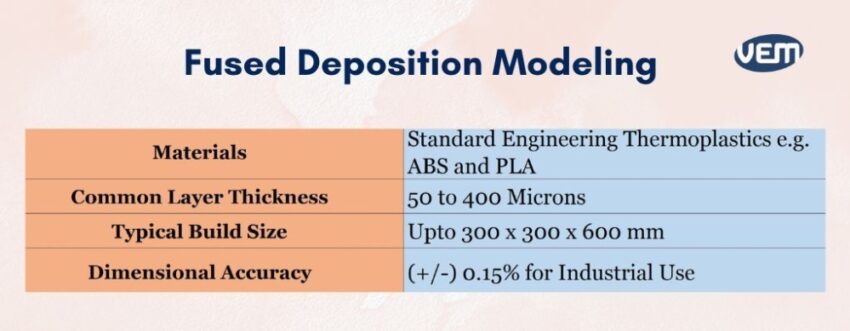
FDM 3D printing can manufacture prototypes and functional parts quickly and cost-effectively. It is best suited to develop basic proof-of-concept models and low-cost prototyping of simpler parts. An array of standard thermoplastics can be used to print via FDM and this gives a wide range of materials to work with.
FDM has the lowest resolution and accuracy when compared to other 3D printing technologies, which means that it is not the best option for printing complex designs or plastic parts with intricate details.
Selective Laser Melting (SLM) and Direct Metal Laser Sintering (DMLS)
Selective laser melting, abbreviated as SLM, and Direct metal laser sintering abbreviated as DMLS are metal additive manufacturing techniques. Their technology is similar to the SLS printers. The only difference is that these techniques instead of using thermoplastic, fuse minute metal particles together layer by layer using a laser. These technologies are ideal for various medical applications. They can be used to manufacture generic implants for the hips, knees, and spine implants, custom implants for trauma treatments, and dentures. These techniques can produce high-performing end-use medical devices using metal that are strong, durable, and biocompatible.
Talking about the cons, metal 3D printers are still very expensive and not easily accessible to most manufacturers. You should also note that metal 3D printing processes generally have a very complex workflow.
Additive Manufacturing Process Highlights for Medical Devices
The below table summarizes the highlights of 3D printing technologies in a comparative manner. It describes the best technique that should be employed for various applications.
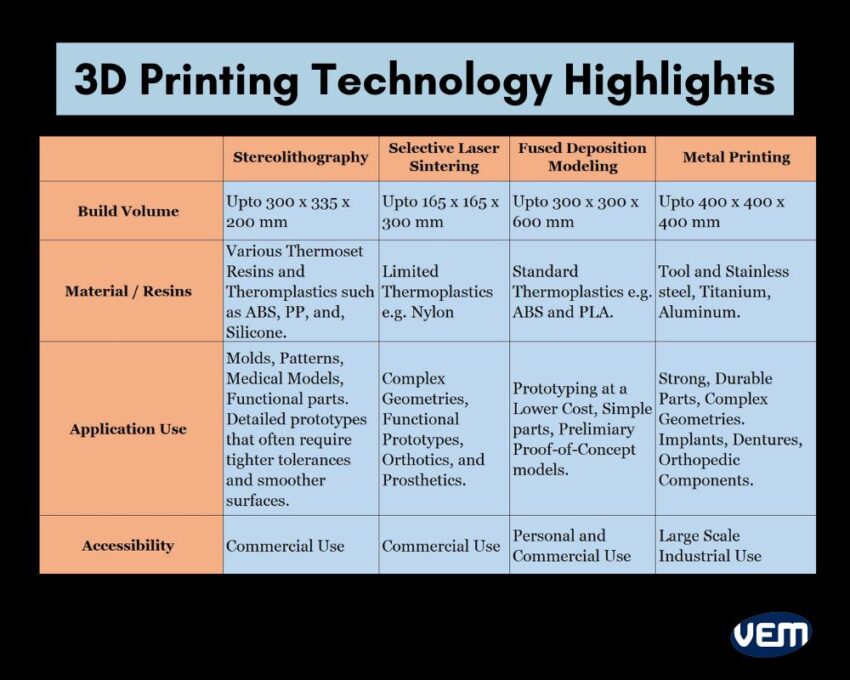
Additive Manufacturing Applications in the Medical Industry
Surgical Tools & Instruments
Various surgical tools and instruments are produced using 3D printing technology. Some examples include forceps, medical clamps, needle drivers, and scalpels. The key benefit of 3D printing surgical tools and instruments is that specific modifications can be made to the designs that are often based on feedback from surgeons. Alterations can be done rapidly, sometimes on the same day, and through the 3D printing technique, it’s now possible to produce customized surgical instruments rapidly.
Surgical tools and instruments are not as invasive as implants and they are thus, comparatively subject to fewer regulatory barriers than others.
Orthopedic Implants
Manufacturing orthopedic implants via 3D printing techniques have helped physicians to successfully replace missing joints and bones. Temporary implantations include fixation devices such as plates, screws, pins, and wires in the body to let fractured bones heal over time whereas permanent implants include joint replacements such as the knee, hip, or wrist implant. Initially, it wasn’t possible to provide customization via traditional manufacturing methods and even if it was, it would be very expensive to provide patient-specific healthcare. Today, 3D-printing techniques have helped physicians and surgeons overcome these limitations. They now have the ability to print complex shapes and structures that allow the manufacturing of perfectly-fitted devices.
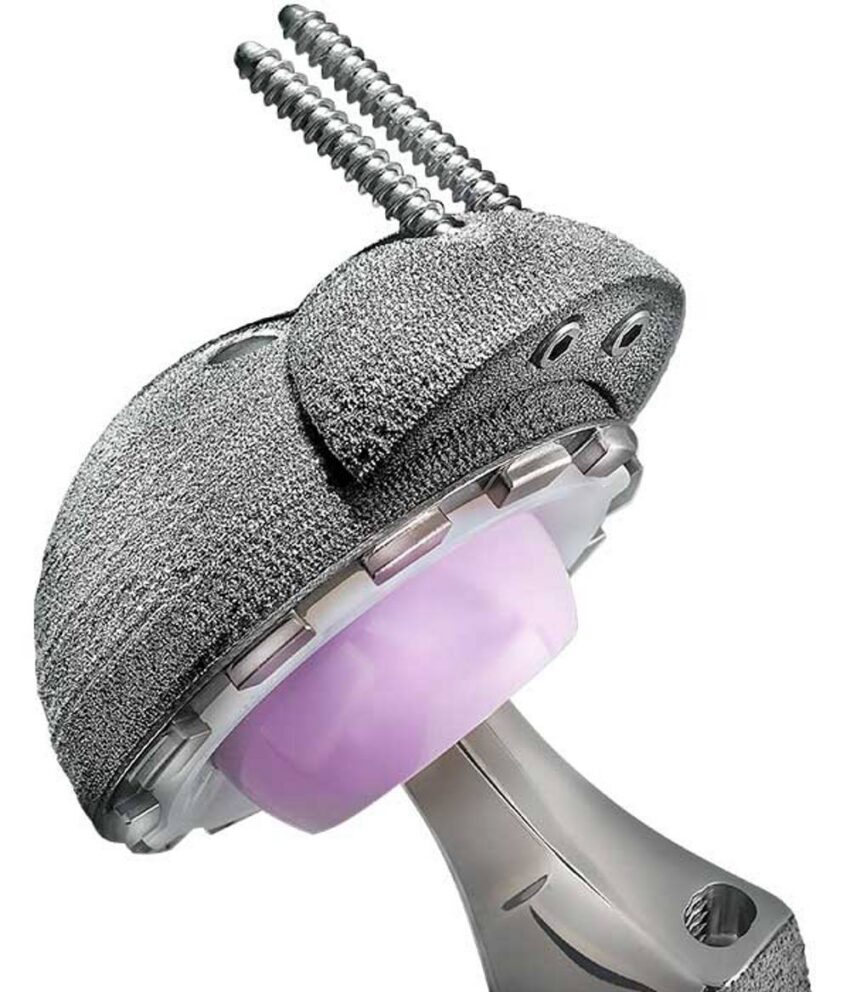
Dental Restorations
3D Printing techniques have proven to be extremely beneficial in the dentistry industry as well! The technology of 3D printing enables the manufacturing of accurate and sturdy dental restorations such as fillings, screws, crowns, bridge replacements, and dentures.
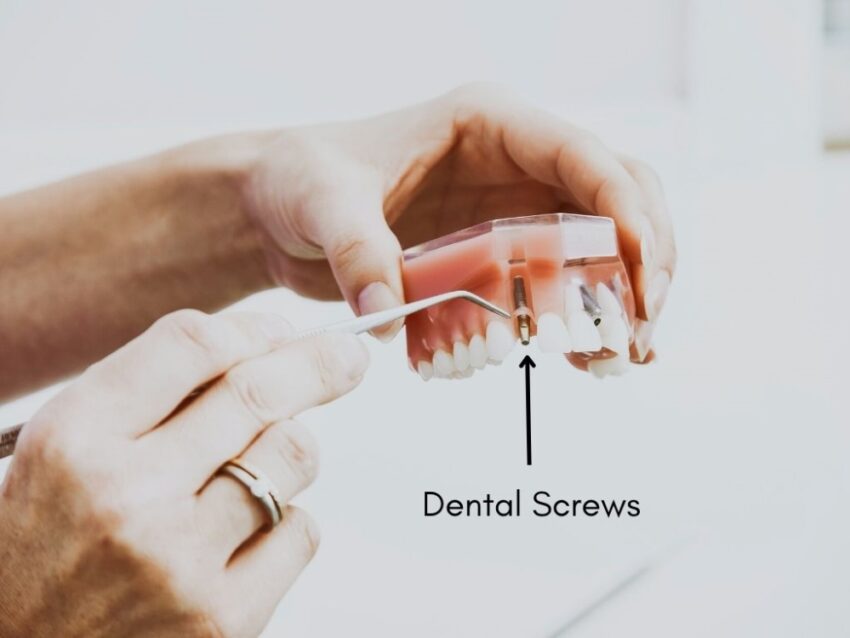
All of these can be 3D-printed and benefit from advances in CAD (computer-aided design) and CAM (computer-aided manufacturing) technology.
Biocompatible Plastic Parts for Additive Manufacturing
It’s entirely dependent upon the application but if medical devices are manufactured, then biocompatibility is a primary concern!
Biocompatibility is a mandate that is required for 510(k) and premarket approval (PMA) submissions in the United States and other regulatory submissions worldwide. It indicates whether the medical device will be compatible with the biological system in which it is intended. These testing requirements are based on the type, area, and exposure duration of the devices. Determining these testing requirements early in the development process will allow ample time to complete testing before submission to regulatory bodies and this is indicated by the contact between the medical device and the human body. You should note that there are three different categories that define contact.
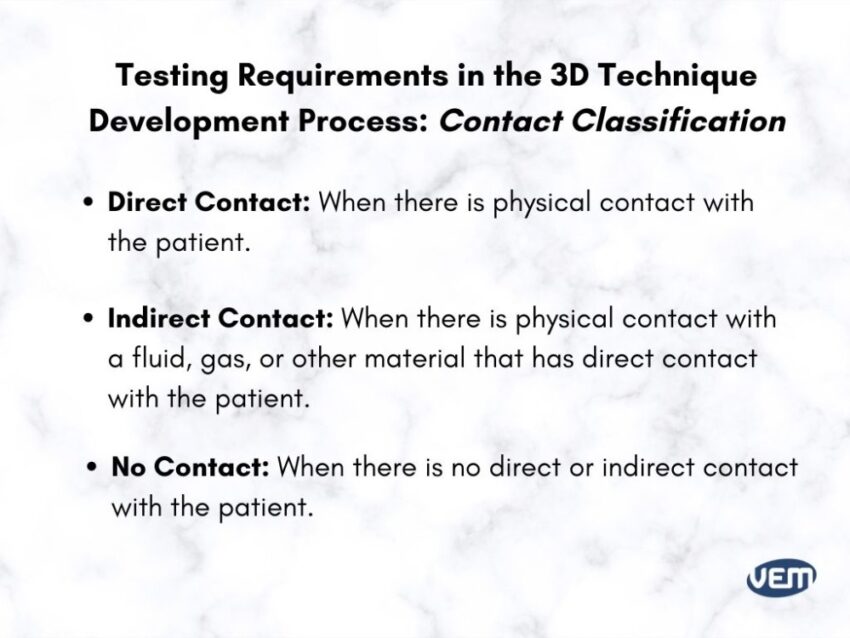
These are listed below:
- Direct Contact is when there is physical contact with the patient.
- Indirect Contact Is when there is physical contact with a fluid, gas, or other material that has direct contact with the patient.
- No Contact is when there is no direct or indirect contact with the patient and is therefore exempt from biocompatibility requirements.
Experienced 3D printing material manufacturers conduct biocompatibility testing based on ISO 10993, ISO 18562, and ISO 7405 standards.
Regulatory Approval of Medical Devices
It is imperative that 3D-printed medical devices meet the standard regulatory guidelines. One of the processes to establish the same is a quality management system (QMS). QMS is a hierarchical system that starts with policies to include procedures, instructions, and documentation.
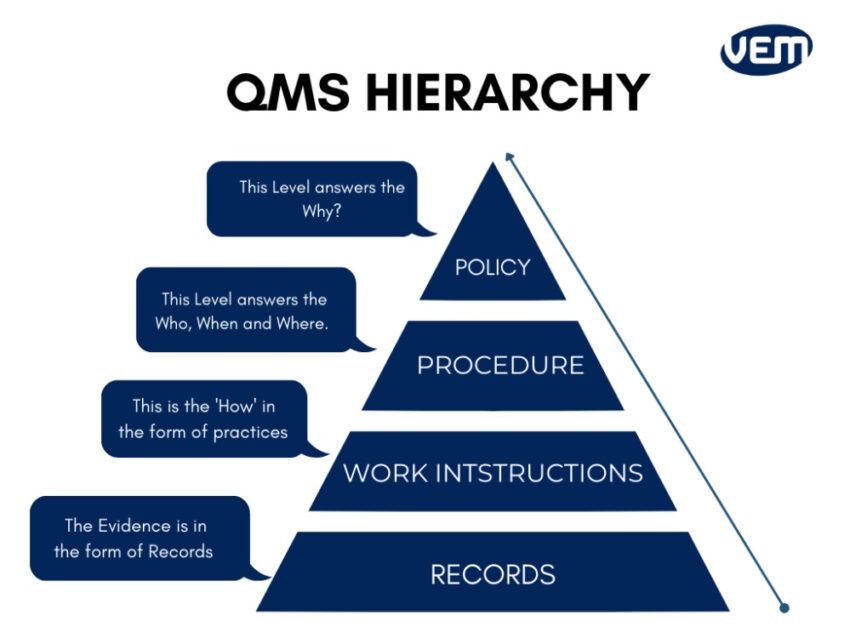
The records in the QMS indicate that the process is followed and medical device regulations are being adhered to. FDA defines these in the 21 CFR Part 820 section for the United State. You should note that these requirements are from the FDA. The approval in the European region needs ISO 13485:2016 quality systems.
Get Started With 3D Printing Medical Devices
3D printing techniques enable quick iteration cycles, shorten the product development cycle, and create more time for creative solutions.
You can reach out to our medical experts and engineers to learn more about 3D printing techniques. Our designers have vast experience and can help you optimize and supplement your current medical device design and manufacturing workflow. VEM-Tooling can prove to be your cutting-edge partner in medical 3D printing!



